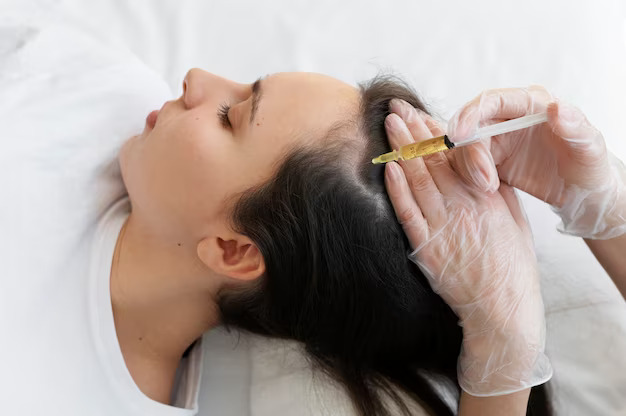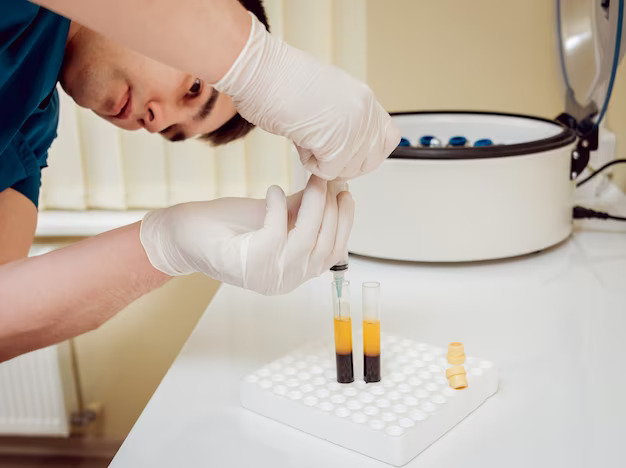English
Do you feel tired when dealing with hair loss and skin concerns that affect your confidence? Look no further because we have the solution you have been searching for in Platelet-Rich Plasma (PRP) therapy. Recently, PRP has gained popularity as a revolutionary treatment option for hair loss and skin rejuvenation. This cutting-edge procedure involves injecting concentrated platelets from blood into targeted areas to stimulate cell regeneration and collagen production. The results? Thicker, healthier hair, revitalized, youthful skin. However, these benefits remain. PRP therapy is a safe and natural alternative to traditional methods, such as hair transplants and cosmetic surgeries, with minimal downtime and virtually no side effects. In this article, we delve deeper into the incredible benefits of PRP for hair loss and skin health, giving you the confidence boost you have been longing for. Get ready to discover the power of PRP and reclaim self-assurance.
Science Behind PRP: How does it work for hair loss and skin health?
PRP therapy works by harnessing the natural healing mechanisms of the body to stimulate hair growth and rejuvenate skin. PRP platelets contain numerous growth factors, including platelet-derived growth factor (PDGF), transforming growth factor-beta (TGF-β), and vascular endothelial growth factor (VEGF). These growth factors have been shown to have profound effects on cell growth, tissue repair, and collagen production.
When PRP is injected into the scalp for hair loss, it provides a concentrated dose of growth factors to hair follicles. These growth factors stimulate dormant hair follicles, promote the growth of new hair strands, and increase the thickness of the existing hair. PRP also improves blood circulation in the scalp, ensuring that the hair follicles receive an adequate supply of nutrients and oxygen for optimal growth.
Similarly, when PRP is injected into the skin for rejuvenation, growth factors stimulate collagen production, which is essential for maintaining young skin. Collagen provides structure and elasticity to the skin; however, its production decreases with age, leading to wrinkles, skin sagging, and uneven texture. By promoting collagen synthesis, PRP helps restore the firmness of the skin, smoothen wrinkles, and improve overall skin tone and texture.
The regenerative properties of PRP extend beyond hair growth and skin rejuvenation properties. PRP has been used to treat various medical conditions including chronic wounds, osteoarthritis, and musculoskeletal injuries, with promising results. Its ability to accelerate healing and promote tissue regeneration makes it a versatile treatment option for a wide range of conditions.
Benefits of PRP for Hair Loss: How PRP can help regrow hair and prevent further hair loss
Hair loss can be distressing for both men and women, affecting their self-esteem and confidence. Although several treatment options are available, such as medications, topical solutions, and hair transplants, PRP offers a natural and effective alternative with numerous benefits.
1. Stimulates Hair Growth
PRP therapy stimulates hair growth by promoting the proliferation of hair follicle cells and increasing the thickness of the existing hair strands. The growth factors present in PRP activate hair follicles, which may become dormant or miniaturized owing to genetic factors, hormonal imbalances, or other underlying causes of hair loss. By jump-starting the hair follicles, PRP helps regrow hair and improves the overall density.
2. Prevents Further Hair Loss
In addition to promoting hair growth, PRP therapy can prevent further hair loss. PRP creates an optimal environment for hair growth by improving the health of hair follicles and increasing the blood circulation in the scalp. It strengthens the existing hair strands, making them less prone to breakage and shedding. With regular PRP treatment, patients can maintain their existing hair and prevent progression of hair loss.
3. Safe and Natural
The key advantage of PRP therapy for hair loss is that it is a safe and natural treatment option. Because the platelets used in PRP are obtained from the patient's own blood, there is a minimal risk of allergic reactions or adverse side effects. PRP is a nonsurgical procedure that does not require incisions or anesthesia, making it a convenient and low-risk option for individuals seeking hair restoration.
4. Minimal Downtime
Unlike traditional hair transplant surgery, PRP therapy requires minimal downtime. The procedure itself takes approximately 30-60 minutes, and patients can resume their normal activities immediately afterward. Some individuals may experience mild redness or swelling at the injection site; however, these side effects typically subside within a few hours of injection. Patients can typically wash their hair the next day and resume regular hair-care routines without restrictions.
5. Versatile Treatment Option
PRP therapy is a versatile treatment option that can be tailored to individual needs and preferences. It can be used as a standalone treatment or in conjunction with other hair restoration techniques such as medication or hair transplant surgeries. PRP can be combined with microneedling, a procedure that creates tiny channels on the scalp to enhance PRP absorption and promote better results. This flexibility allows healthcare providers to customize treatment plans based on the severity of hair loss and patient goals.
In summary, PRP therapy offers a range of benefits to individuals with hair loss. It stimulates hair growth, prevents further hair loss, and provides a safe and natural alternative to the traditional hair restoration methods. With its minimal downtime and versatility, PRP therapy has become a popular choice for individuals seeking effective and long-lasting solutions for hair


Beautiful, youthful-looking skin is something that we desire. However, factors such as aging, sun damage, and lifestyle choices can affect the skin, leading to wrinkles, fine lines, uneven textures, and dullness. Although numerous skincare products and treatments are available, PRP therapy offers a unique set of benefits that can significantly improve skin health and appearance.
1. Stimulates Collagen Production
Collagen is a protein that provides structure and elasticity to skin. Collagen production decreases with age, leading to the formation of wrinkles, skin sagging, and volume loss. PRP therapy stimulates collagen production by delivering concentrated doses of growth factors to skin. These growth factors activate fibroblasts, which are responsible for collagen synthesis, and promote the production of new collagen fibers. An increase in collagen improves skin firmness, reduces the appearance of wrinkles, and enhances overall skin texture.
2. Restores Skin Volume
The loss of facial volume is a common concern associated with age. Areas such as cheeks, temples, and under-eye hollows can appear sunken, making us look tired and ageing. PRP therapy can help restore facial volume by stimulating the production of collagen and hyaluronic acid, which are substances that attract and retain moisture in the skin. The increased collagen and hyaluronic acid levels plump up the skin, fill hollow areas, and restore a young, radiant appearance.
3. Improves Skin Tone and Texture
Uneven skin tone and texture often results from sun damage, acne scars, or hyperpigmentation. PRP therapy can address these concerns by promoting skin cell turnover and regeneration. The growth factors in PRP stimulate the production of new, healthy skin cells, breaking down pigmented cells and promoting their elimination. This leads to a more even skin tone and a smoother and more refined skin texture.
4. Reduces the Appearance of Acne Scars
Acne scars can cause frustration and affect self-consciousness. PRP therapy has shown promising results in reducing the appearance of acne scars and improving overall skin texture. By stimulating collagen production and promoting cell turnover, PRP helps fill depressed scars and smoothen the skin surface. They also improve the healing response of the skin, making it less prone to future breakouts and inflammations.
5. Natural and Safe
Similar to its benefits in hair loss, PRP therapy for skin rejuvenation is a safe and natural treatment option. Since the platelets used in PRP are obtained from the patient's own blood, there is a minimal risk of allergic reactions or adverse side effects. PRP is a nonsurgical procedure that does not require incisions or anesthesia, making it a convenient and low-risk option for individuals seeking skin rejuvenation.
In summary, PRP therapy offers a range of benefits for individuals seeking to improve their skin health and appearance. It stimulates collagen production, restores facial volume, improves skin tone and texture, reduces the appearance of acne scars, and provides a safe and natural alternative to the traditional skin rejuvenation methods. Whether you can help reduce wrinkles, improve skin texture, or achieve a more youthful appearance.
PRP Treatment Process: What to expect during a PRP session
PRP therapy is a straightforward and relatively quick procedure that can be performed in a single session. The treatment process typically involves the following steps:
1. Consultation: The first step in the PRP treatment process is consultation with a qualified health care provider. During this consultation, the provider will evaluate your specific concerns, assess the suitability of PRP therapy for your condition, and discuss the expected outcomes and potential risks.
2. Preparation: Once you have decided to proceed with the PRP therapy, the provider begins the preparation process. A small amount of blood was drawn from the arm, similar to the routine blood test. The blood sample was then placed in a centrifuge that spins the blood at high speeds to separate platelets from other blood components. This process takes approximately 10-15 minutes.
3. Injection: After the preparation process was complete, concentrated platelets, known as platelet-rich plasma, were extracted by centrifugation. PRP was then injected into the target area. The injection site may be numbed with local anesthetic to minimize discomfort during the procedure. The provider will use a fine needle to inject PRP into desired areas, such as the scalp for hair loss or the face for skin rejuvenation.
4. Post-treatment Care: Once the PRP has been injected, the provider may apply a topical antibiotic ointment or dressing to the injection site to prevent infection. Specific instructions may be provided on how to care for the treated area, such as avoiding excessive sun exposure, refraining from vigorous exercise, and using gentle skincare products. Therefore, it is essential to follow these instructions to ensure optimal healing.
5. Follow-up: Depending on the specific needs and treatment plan, multiple PRP sessions may be required to achieve desired results. The provider schedules follow-up appointments to monitor progress, assess the effectiveness of the treatment, and make any necessary adjustments to the treatment plan.
It is important to note that the PRP treatment process may vary slightly depending on the clinic or the healthcare provider. During your consultation, your provider will explain the details of the procedure, answer any questions, and provide personalized information and recommendations.
PRP vs. Other Hair Loss and Skin Health Treatments: A comparison of PRP with other options
Numerous treatment options are available for hair loss and skin health concerns. Each option has its own set of benefits, considerations, and expected outcomes. Let us explore how PRP therapy is comparable with other common treatments for hair loss and skin health.
Hair Loss Treatments
1. Medications (e.g., minoxidil, finasteride): Medications like Minoxidil and finasteride are commonly used to treat hair loss. Although they can effectively slow hair loss and promote hair growth, they often require long-term use and may have side effects. PRP therapy offers a natural and safe alternative to medications, providing long-lasting results without the need for daily medication.
In contrast2. Hair transplant surgeries involve removing hair follicles from one area of the scalp ( donor site) and transplanting them to areas of thinning or balding
( recipient site). Although hair transplants can provide permanent restoration, they are invasive procedures that require incisions, sutures, and recovery. PRP therapy is a nonsurgical treatment option with minimal downtime and no incisions.
3. Laser Therapy: Low-level laser therapy (LLLT) is a non-invasive treatment option that uses red light to stimulate hair growth. While LLLT can be effective in some individuals, it often requires frequent sessions and may take several months to obtain visible results.

